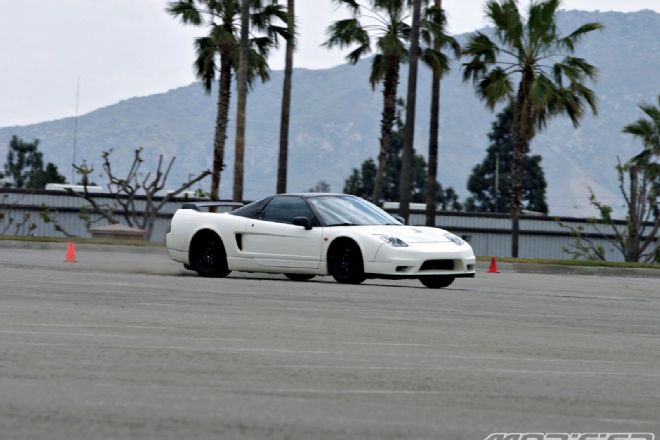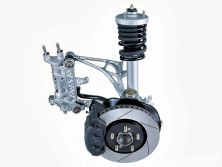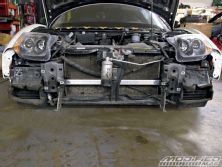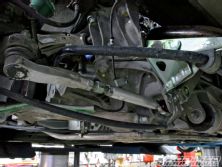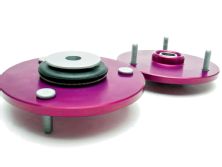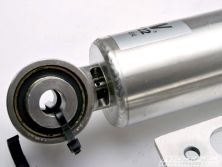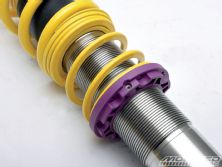There isn’t much to be done to an NSX when it comes to making it handle better. More times than not, most changes made aren’t improvements at all. Even slight changes in wheel and tire sizing might drastically change the car’s limit-handling character.
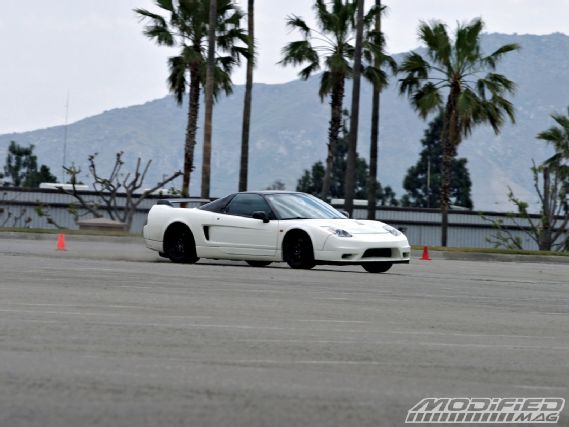 |
Acura NSX KW V3 and Clubsport Suspension - Supercar Suspension Zee German Way
|
Acura NSX KW V3 and Clubsport Suspension - Supercar Suspension Zee German Way
Coilovers We originally wanted to use the KW V3 coilover kit on our NSX project. The V3 is a true street coilover which uses a stainless steel shock body, appropriately soft spring rates and stroke lengths, and is designed to be used with the original factory upper mount. The reason for the stock upper mounts is the stringent safety standards implemented by the German TUV regulations, which has now been adopted by most EU countries. Since all road-going vehicles in Germany have a regular safety inspection, in addition to smog testing, all aftermarket parts used on these vehicles must also be TUV approved. This is why KW designs its V3 kits to be used with OEM upper mounts and non-adjustable shock body lengths. Having non-adjustable body lengths is also KW’s way of guaranteeing that cars are not lowered past TUV maximum safety camber limits (when the vehicle is at fully loaded weight) or slammed to the point where tires can potentially contact the chassis. All these anal safety measures make sense when you remember that KW customers typically commute at more than 100 mph on the autobahn.
Unfortunately, the need to change suspension becomes unavoidable as the car gets older. At 18 years old, our suspension was due for an overhaul. With OEM NSX parts costing a fortune, you’re better off looking for a higher-quality, less mass-produced suspension in the aftermarket. Fortunately, the NSX market isn’t flooded with cheap imitation suspension brands. Only the best brands and manufacturers like TEIN, JRZ, MOTON, Penske and a few other private labels bother making products for the NSX. But we wanted to be different. So we made a phone call to KW Suspensions’ head honcho, Klaus Wohlfarth, to see if the company was interested in building a KW coilover kit for the NSX. It was a longshot, but Klaus immediately agreed and put the plan into motion.
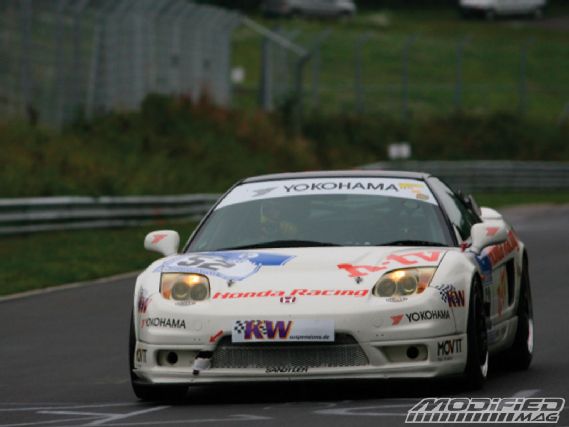 |
Final evaluation and validation on the Nürburgring.
|
Final evaluation and validation on the Nürburgring.
A couple months later, I got an email invitation to Germany. In a matter of months, Klaus had scoured all of Europe and dug up two NSXs (including a JDM Type-R race car) for development cars and wanted me to be there to witness the final development process and testing of the two cars at the Nürburgring. While the weather didn’t work out and the rained-out track didn’t provide accurate back-to-back lap times, we did get to see the entire KW operation and how the company developed a suspension kit from initial measurement, to damping testing on its seven-post suspension shaker machine (bought from the BAR Honda F1 team), to final track testing.
But we got greedy, and in anticipation of some minor track testing in the future, we convinced the KW guys to upgrade from the V3 to the Clubsport kit that’s intended for weekend warriors. (We tried for their full race three-way-adjustable, external reservoir, monotube setup, but were turned down by their very sensible German logic.) The Clubsport is, like the V3, a low-speed rebound and compression damping adjustable coilover built around the same architecture. The only difference in this case is a shorter body length to accommodate the KW pillowball upper mounts and higher spring and damping rates for the shorter stroke. If you’re not planning to track your NSX, don’t be greedy and stick with the V3s.
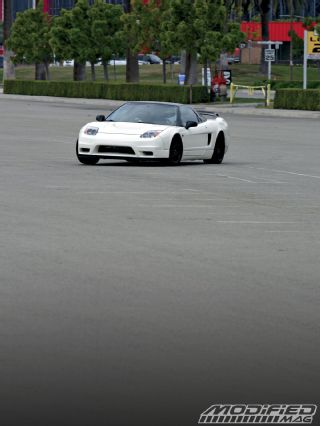 |
Acura NSX KW V3 and Clubsport Suspension - Supercar Suspension Zee German Way
|
Acura NSX KW V3 and Clubsport Suspension - Supercar Suspension Zee German Way
In addition to KW’s attention to detail, much of the reason why we went with the company is because of its philosophy of using relatively lower spring rates, but better damping control for a softer overall ride and similarly effective handling prowess. While spring stiffness supports the weight of the vehicle under steady state conditions, proper damping control is what actually keeps the tires planted and the chassis stable. This is why KW allows for low piston speed rebound damping adjustment like most other adjustable dampers (which affects chassis motion) and compression adjustment (which controls dynamic grip and how well the tires stay planted as they bump through a corner). These adjustments are typically only available on much more expensive race shocks.
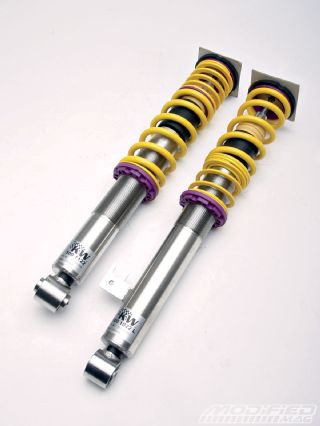 |
The KW Clubsport features independently user-adjustable, low piston speed compression (bottom of the damper) and rebound (top) damping settings.
|
The KW Clubsport features independently user-adjustable, low piston speed compression (bottom of the damper) and rebound (top) damping settings.
Bye Bye, Toe Steer
Now that we had some stiffer-than-stock spring rates, we wanted to compensate for some of the odd toe steer that Honda designed into the stock suspension. Although the NSX is, by design, meant for performance and already uses hard rubber bushings, we decided to take some of the rubber slop out of critical links that affect toe change. Shad Huntley of what was once Comptech, and now owner of his own shop Driving Ambition, supplied us with a Comptech rear non-compliance toe link, bushing and front suspension clamp. Both the rear toe link and the bushings replace the stock hardware with mono-ball type joints as these two components have the biggest affect on rear-wheel toe change. By changing out the stock hardware and eliminating excessive toe steer in the rear, we can also dial out a lot of the static toe-in from the stock alignment, which will reduce the excessive tire wear that NSXs are known for.
On the front suspension, we also had to address one of the quirky designs that Honda engineers came up with. To prevent bumpsteer in the front suspension, Honda implemented what it called a compliance pivot on the front suspension, which in essence gives the front suspension even more slop to avoid toe change. It sounded like a roundabout way to get around bumpsteer instead of just increasing the spring rate. But now that we have a slightly higher spring rate, we decided to inhibit the compliance pivot by installing a non-compliance clamp from Driving Ambition. Now our suspension acts like how a double A-arm suspension should.
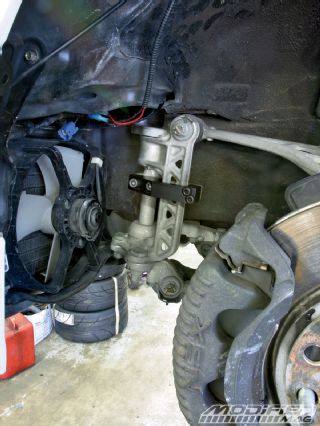 |
The non-compliance clamp for the suspension simply slides over the stock compliance pivot and bolts to the chassis to prevent suspension movement. This isn’t necessary for a street car and can be a point to rub against if you’re running fatty front tires.
|
The non-compliance clamp for the suspension simply slides over the stock compliance pivot and bolts to the chassis to prevent suspension movement. This isn’t necessary for a street car and can be a point to rub against if you’re running fatty front tires.
Last of all are the braces. We threw out the OEM steel rear strut tower brace for a larger Carbing aluminum brace that bolts to all three of the shock tower bolts instead of just two. In the front, we added a set of NSX R aluminum braces from ScienceofSpeed. And underneath, the stock antiroll bars are now replaced with Dali Racing adjustable bars for final roll stiffness tuning.
Next time, we’ll finish off our NSX project with some transmission work and find more speed with the same power.
At the track, our chassis setup work paid off. On the Figure 8 test, the NSX broke into the high 24-second range of lap times and pulled off an average of 1 lateral g. Not bad for very streetable Advan Neova tires. The only other time we’ve achieved 24-second lap times was in a hopped-up EVO 9 on race tires. While the NSX can pull off the numbers, it’s by no means easy to drive like an EVO or STi. Going fast through the corners means having the mid-engine car finely balanced in an inertial slide with neutral steering and very delicate throttle input. Too little and the car loses momentum and begins to push like all mid-engine cars do when they’re unhappy. Too much gas and the tail end will come around faster than you can catch it with the manual steering, resulting in a series of tank-slappers that you never want to experience as the owner of one of these cars. With more practice or under more skilled hands (our test driver just doesn’t fit inside an NSX), we could have easily matched our 24.5-second record Figure 8 lap time.
Going Faster For Free
How Real Racers Align A Car
There’s one major difference between tuner cars and true race cars; what makes them faster on track is the setup and testing. Ironically, the setup portion is something that can be done almost for free by just about anyone. Instead of sending our NSX off to some fancy and expensive alignment shop, we decided to spend a long evening with Dan Garder and John McNulty from Scion’s defending national champion, factory-backed road racing team to get a real race-quality alignment.
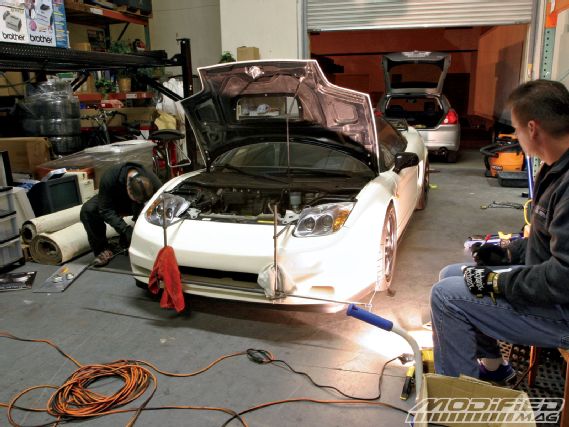 |
Acura NSX KW V3 and Clubsport Suspension - Supercar Suspension Zee German Way
|
Acura NSX KW V3 and Clubsport Suspension - Supercar Suspension Zee German Way
Any real racer will frown on putting their cars on a fancy modern alignment rack. Instead, they use a simple setup of strings, plumb-bobs, a camber gauge (which can cost less than some four-wheel alignments) and a machinist’s ruler to get an alignment that’s far superior (even NASCAR still does this). After setting the car’s ride height with the driver’s weight in the car (since there’s no point of corner-balancing a street car), we set the front and rear camber with a camber gauge. You can actually set the camber with the car in the air by taking the difference of the static camber on the ground and the car in the air. Using the rotors as a relative camber reference to the wheels also lets you take the wheels off to set the camber. Dan and John then strung up a pair of strings on each side of the car exactly parallel to the center line and equidistant from front and rear wheel centers. We used a hanger rig, but you can copy the same technique using strings tied to jackstands. By measuring the difference in distance from the front and rear of the rim to the string, you can establish exact toe measurements down to even a 32th of an inch. This method also lets you get a perfect toe alignment with the steering wheel dead center. The best part is that you’re the person doing the alignment, so there’s no limit to the level of anal retention you put into your own car, you just need a lot of time.
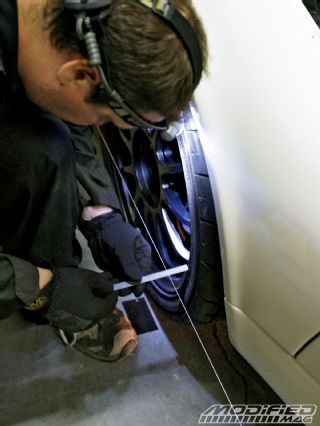 |
Acura NSX KW V3 and Clubsport Suspension - Supercar Suspension Zee German Way
|
Acura NSX KW V3 and Clubsport Suspension - Supercar Suspension Zee German Way

